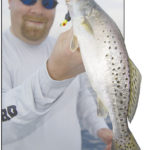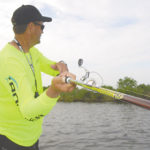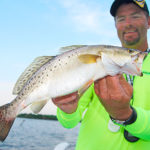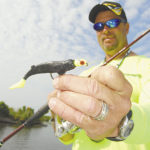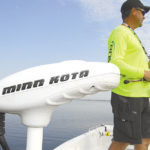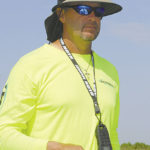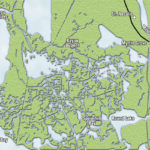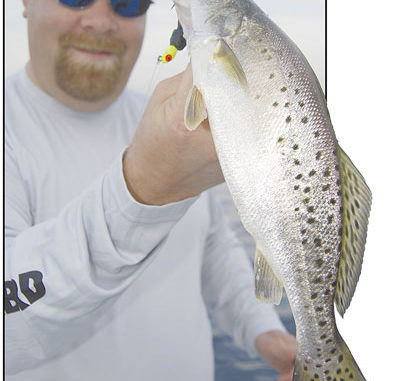
Divide Lafitte up into four sections, and you’ll load the boat this summer no matter what the wind is doing.
It’s a long way from the icy lakes of Mankato, Minn., to the tepid swamps of Southeast Louisiana.So even though fishing is his living, Tim Price had only wet a line here once before. He had been down for one of the Bassmasters Classics, and took advantage of the opportunity to battle a few reds in the upper Barataria Basin.
He had loved the experience, but while he was here, he noticed how much the locals revere speckled trout.
And in his job as pro team coordinator for Minn Kota, Price feels it’s his duty to catch all the types of fish his clients target. That’s just the kind of guy he is. It’s brutal work, but hey, somebody’s got to do it.
So Price drug himself to the airport last month, and caught a redeye to Armstrong International because duty called. Minn Kota was one of the sponsors of an industry event designed to put new products to the test in the challenging environment of Southeast Louisiana.
Just because it was part of the job, Price happened to mention to Capt. Theophile Bourgeois his trout-virgin status.
That was music to the accommodating captain’s ears.
“The trout just showed up, literally, two or three days ago,” he said. “You want trout, we’ll catch trout.”
The day had dawned mostly overcast and dead-calm when Bourgeois backed his 24-foot bay boat from his Barataria Waterway dock. He could have pointed the bow in virtually any direction, and ended up with fish in the boat.
He was entirely unlimited by the conditions. Everything from the beaches of Grand Isle to the oyster reefs of northern Barataria Bay was in play. The rigs were an option; so were the rocky shorelines of Little Lake.
But Bourgeois forsook them all to fish an area that would seem to be at the bottom of his bag of tricks — the type of area the average guy would fish only if the wind blew all other options off the table.
He headed to the ponds off Bayou Dupont, and it proved to be a wise choice. Three casts into the day, Price caught his first trout.
“There’s always fish in these marshes, and they’ll be here throughout the summer,” Bourgeois said.
That’s great news for anglers who launch in Lafitte with visions of slick-calm water and Barataria Bay limits in their heads. Mother Nature, particularly in June, doesn’t always play fair. The weatherman may call for calm seas, the flags at the marina may indicate calm seas, but a run to the enormous bay will reveal anything but calm seas.
The stubborn angler might beat himself to death to get to his favorite rig or reef and drown live shrimp in filthy water.
The smart angler will make a U-turn, and set the GPS for an area bordered roughly by Bayou Dupont, Myrtle Grove Canal, Round Lake and Bayou Rigolets.
“You take that big square, divide it in four, and say, ‘O.K., I’m going to focus on one of those little squares today,” Bourgeois said.
And how do you pick exactly which of the little squares to focus on? That’s easy, Bourgeois said.
“If the wind’s out of the east or southeast, I’m not going to go west,” he said. “The water will be dirtier. I’m going to go to the east.”
Once an angler settles on a quadrant, catching fish is simply a matter of reading conditions and capitalizing on them.
Bourgeois looks for the ponds rimmed by broken marsh, and then concentrates on points, pockets and trenasses. The points typically hold more trout, while the pockets and trenasses hold more redfish.
On windy days, the broken-up nature of his select ponds allows Bourgeois to use the wind as well as the tide to his advantage.
“The wind’s going to blow water and bait around a point, and the fish will be on the back side of that point,” he said.
But sustained wind can make some points unproductive.
“If the wind’s been blowing for three days, I’m going to fish the lee side of the pond. The points on the windward side will be dirty,” Bourgeois said. “I’m always looking for water clarity.”
He also watches the tide to determine where to fish. During really strong tides — 1.5 to 2 feet — fish pull off the points, and tuck into the eddies. The same thing happens at trenasse mouths.
“Fish aren’t going to be in all that current,” Bourgeois said. “They’re going to get just off that current break.”
Although Bourgeois will fish virtually every point he encounters, his favorites are those that border the deepest water in the pond. Every pond will have some type of channel through which water enters and exits the pond. It my be only a foot deeper than the rest of the pond, but that will be enough relief to attract the attention of predators, which know the swifter currents in the deeper water tend to channel baitfish.
In order for any geographical feature — point, pocket or trenasse — in a pond to be productive, the tide must be moving to some degree. If it’s not, predator fish have no reason to focus on the current breaks. Baitfish will be randomly spread out throughout the pond, and they’ll be virtually uncatchable by the predators.
As a consequence, predators won’t feed much, and will spend their days moseying along slowly, waiting for the water to start moving.
“A perfect-10 day for fishing these ponds in Lafitte is a tide that’s high and falling,” Bourgeois said. “If you get in here and the tide’s high and falling, the water’s clear and you find bait, you’re going to catch fish.”
Anglers who want to up the odds for success should pay attention to tide charts and winds, and try to pick days and even hours when the tides should be high and falling.
What Bourgeois typically does is follows the falling tide up the estuary. He said there’s about a four-hour delay between the tides at the northern edge of Barataria Bay and Lafitte. He’ll start his day south and work his way north to maximize his time in the best tidal condition.
Bourgeois said a range of at least .6 is ideal.
“But if you’re a weekend warrior, and you’re taking the dog, the kids and the mother-in-law, you can only go when you can go. The conditions are what they are,” Bourgeois said.
As long as the water’s moving at all, the fish will still be feeding somewhere, he said.
Of the various necessities for this type of fishing, none is more important than a trolling motor with well-charged batteries.
“You’ve got to move a lot,” Bourgeois said. “Just leave the anchor in the box. Hit a point, and if you don’t catch anything, troll to the next point. Hit the pockets and trenasses along the way. Sooner or later, you’re going to run into some fish. Work that point until the fish quit, and then move to the next point.”
It’s a fun way to fish that usually results in heavy boxes with a variety like that of an aquarium at a seafood restaurant.
“There are lots of lagniappe fish in Lafitte,” Bourgeois said. “You might be thinking reds, and you catch a bunch of trout. You might be thinking trout, and you catch a bunch of flounder.
“From Bay Six and Bay Round north, you’ll catch bass as well.”
Price started the day thinking trout, and after he put that notch in his rod, never complained one iota when a redfish sucked in his bait.
“This is an excellent fishery,” he said with classic Midwestern understatement.
So it looks like he’s going to have to come back.
The man’s just doing his job.
Capt. Theophile Bourgeois can be reached at (504) 341-5614.
